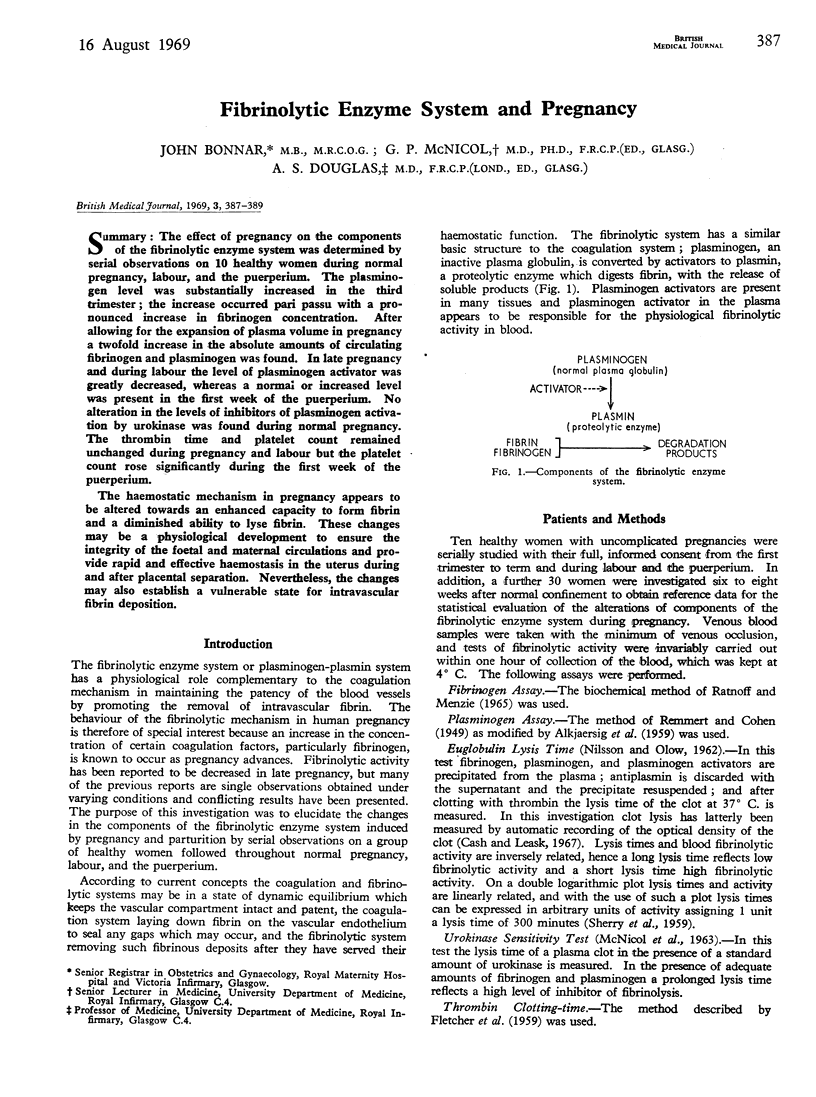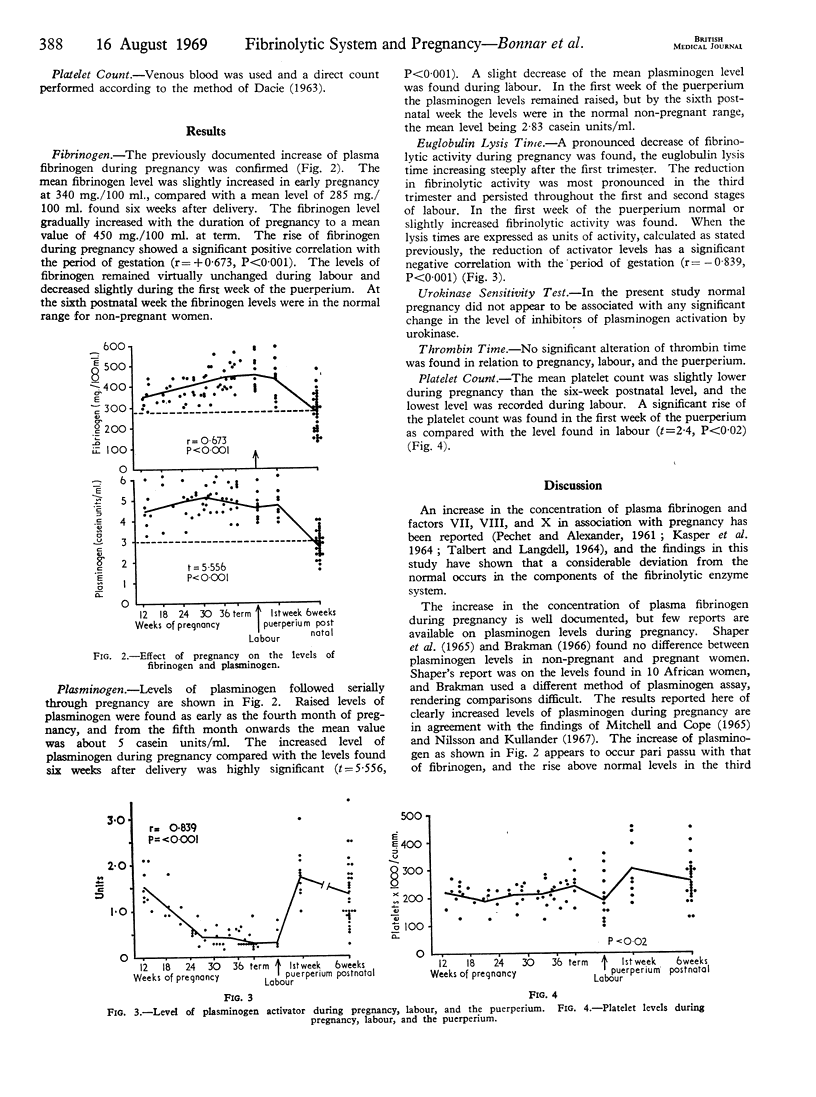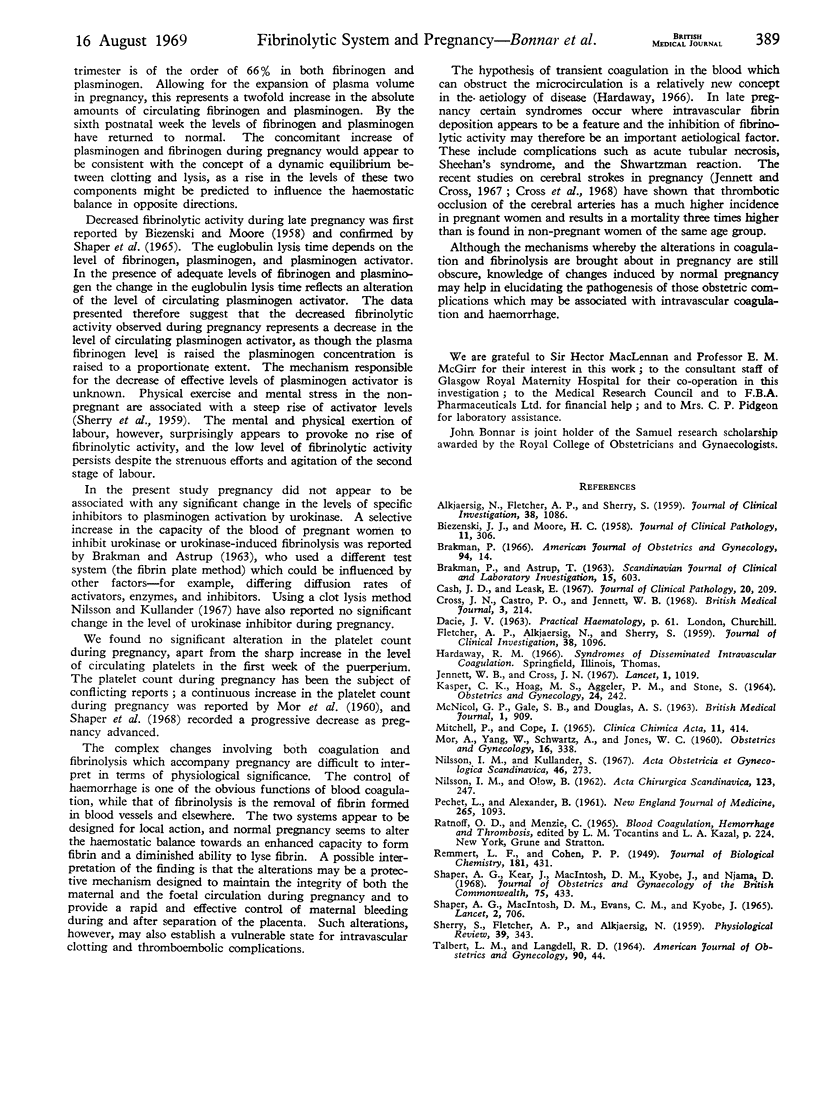Abstract
The effect of pregnancy on the components of the fibrinolytic enzyme system was determined by serial observations on 10 healthy women during normal pregnancy, labour, and the puerperium. The plasminogen level was substantially increased in the third trimester; the increase occurred pari passu with a pronounced increase in fibrinogen concentration. After allowing for the expansion of plasma volume in pregnancy a twofold increase in the absolute amounts of circulating fibrinogen and plasminogen was found. In late pregnancy and during labour the level of plasminogen activator was greatly decreased, whereas a normal or increased level was present in the first week of the puerperium. No alteration in the levels of inhibitors of plasminogen activation by urokinase was found during normal pregnancy. The thrombin time and platelet count remained unchanged during pregnancy and labour but the platelet count rose significantly during the first week of the puerperium.
The haemostatic mechanism in pregnancy appears to be altered towards an enhanced capacity to form fibrin and a diminished ability to lyse fibrin. These changes may be a physiological development to ensure the integrity of the foetal and maternal circulations and provide rapid and effective haemostasis in the uterus during and after placental separation. Nevertheless, the changes may also establish a vulnerable state for intravascular fibrin deposition.
Full text
PDF


Selected References
These references are in PubMed. This may not be the complete list of references from this article.
- ALKJAERSIG N., FLETCHER A. P., SHERRY S. The mechanism of clot dissolution by plasmin. J Clin Invest. 1959 Jul;38(7):1086–1095. doi: 10.1172/JCI103885. [DOI] [PMC free article] [PubMed] [Google Scholar]
- BIEZENSKI J. J., MOORE H. C. Fibrinolysis in normal pregnancy. J Clin Pathol. 1958 Jul;11(4):306–310. doi: 10.1136/jcp.11.4.306. [DOI] [PMC free article] [PubMed] [Google Scholar]
- BRAKMAN P., ASTRUP T. SELECTIVE INHIBITION IN HUMAN PREGNANCY BLOOD OF UROKINASE INDUCED FIBRINOLYSIS. Scand J Clin Lab Invest. 1963;15:603–609. doi: 10.3109/00365516309051342. [DOI] [PubMed] [Google Scholar]
- Brakman P. The fibrinolytic system in human blood during pregnancy. Am J Obstet Gynecol. 1966 Jan 1;94(1):14–20. doi: 10.1016/0002-9378(66)90374-7. [DOI] [PubMed] [Google Scholar]
- Cash J. D., Leask E. Mutichannel system for the automatic recording of clot lysis. J Clin Pathol. 1967 Mar;20(2):209–211. doi: 10.1136/jcp.20.2.209. [DOI] [PMC free article] [PubMed] [Google Scholar]
- Cross J. N., Castro P. O., Jennett W. B. Cerebral strokes associated with pregnancy and the puerperium. Br Med J. 1968 Jul 27;3(5612):214–218. doi: 10.1136/bmj.3.5612.214. [DOI] [PMC free article] [PubMed] [Google Scholar]
- FLETCHER A. P., ALKJAERSIG N., SHERRY S. The maintenance of a sustained thrombolytic state in man. I. Induction and effects. J Clin Invest. 1959 Jul;38(7):1096–1110. doi: 10.1172/JCI103886. [DOI] [PMC free article] [PubMed] [Google Scholar]
- Jennett W. B., Cross J. N. Influence of pregnancy and oral contraception on the incidence of strokes in women of childbearing age. Lancet. 1967 May 13;1(7498):1019–1023. doi: 10.1016/s0140-6736(67)91539-5. [DOI] [PubMed] [Google Scholar]
- KASPER C. K., HOAG M. S., AGGELER P. M., STONE S. BLOOD CLOTTING FACTORS IN PREGNANCY: FACTOR 8 CONCENTRATIONS IN NORMAL AND AHF-DEFICIENT WOMEN. Obstet Gynecol. 1964 Aug;24:242–247. [PubMed] [Google Scholar]
- MCNICOL G. P., GALE S. B., DOUGLAS A. S. In-vitro and in-vivo studies of a preparation of urokinase. Br Med J. 1963 Apr 6;1(5335):909–915. doi: 10.1136/bmj.1.5335.909. [DOI] [PMC free article] [PubMed] [Google Scholar]
- MITCHELL P., COPE I. THE ESTIMATION OF PLASMINOGEN IN HUMAN SERUM OR PLASMA. Clin Chim Acta. 1965 May;11:414–423. doi: 10.1016/0009-8981(65)90188-9. [DOI] [PubMed] [Google Scholar]
- MOR A., YANG W., SCHWARZ A., JONES W. C. Platelet counts in pregnancy and labor. A comparative study. Obstet Gynecol. 1960 Sep;16:338–343. [PubMed] [Google Scholar]
- Nilsson I. M., Kullander S. Coagulation and fibrinolytic studies during pregnancy. Acta Obstet Gynecol Scand. 1967;46(3):273–285. doi: 10.3109/00016346709158632. [DOI] [PubMed] [Google Scholar]
- PECHET L., ALEXANDER B. Increased clotting factors in pregnacy. N Engl J Med. 1961 Nov 30;265:1093–1097. doi: 10.1056/NEJM196111302652205. [DOI] [PubMed] [Google Scholar]
- REMMERT L. F., COHEN P. P. Partial purification and properties of a proteolytic enzyme of human serum. J Biol Chem. 1949 Nov;181(1):431–448. [PubMed] [Google Scholar]
- SHERRY S., FLETCHER A. P., ALKJAERSIG N. Fibrinolysis and fibrinolytic activity in man. Physiol Rev. 1959 Apr;39(2):343–382. doi: 10.1152/physrev.1959.39.2.343. [DOI] [PubMed] [Google Scholar]
- Shaper A. G., Macintosh D. M., Evans C. M., Kyobe J. Fibrinolysis and plasminogen levels in pregnancy and the puerperium. Lancet. 1965 Oct 9;2(7415):706–708. doi: 10.1016/s0140-6736(65)90451-4. [DOI] [PubMed] [Google Scholar]
- TALBERT L. M., LANGDELL R. D. NORMAL VALUES OF CERTAIN FACTORS IN THE BLOOD CLOTTING MECHANISM IN PREGNANCY. Am J Obstet Gynecol. 1964 Sep 1;90:44–50. doi: 10.1016/s0002-9378(16)34890-6. [DOI] [PubMed] [Google Scholar]


